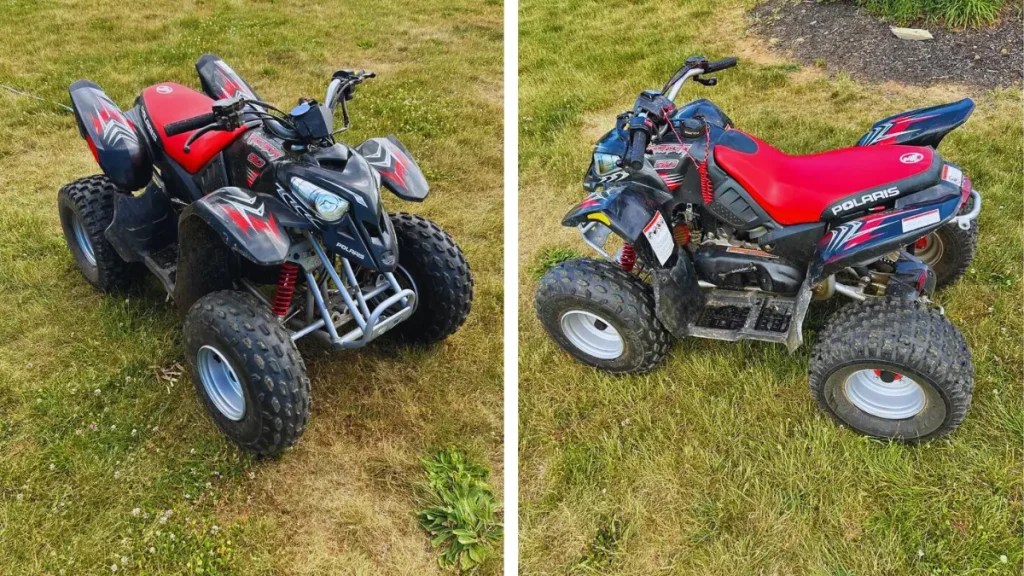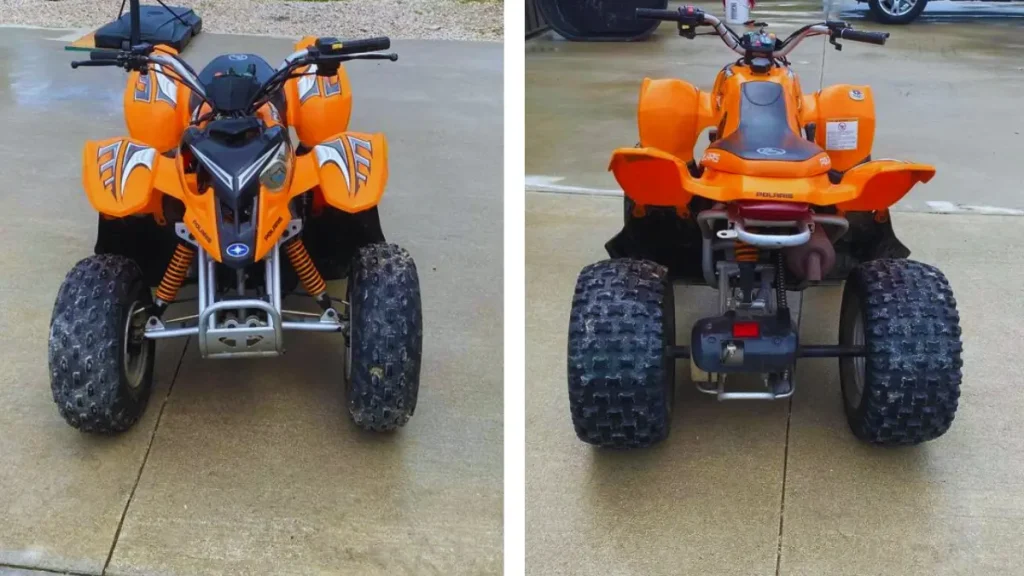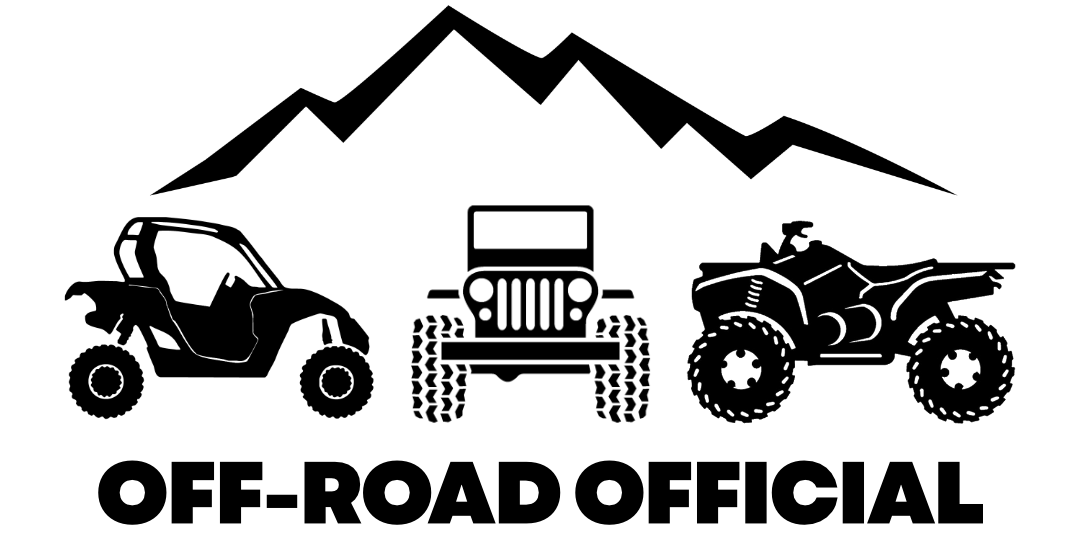Back in the early 2000’s, the youth ATV industry was booming and Polaris had just begun to test the market with some of their first youth models.
Since Polaris was not yet recognized as one of the top dawgs in the ATV industry at the time, they knew they needed to make a splash to gain ground in the growing youth market.
They did just that with the introduction of the Polaris Predator 90.
And you may be surprised to find out that this old model still holds its own with some of today’s best youth models, including the Tracker 90 ATV and the Yamaha Raptor 90.
This guide will detail the top speed, main strengths and weaknesses, and key features of this classic youth quad.
About The Polaris Predator 90
The Polaris Predator 90 was a youth ATV that splashed onto the scene in 2003 to take the place of the Scrambler 90 and Scrambler X youth models.
As Polaris aimed to gain a larger portion of the youth ATV industry from the Japanese models that ruled the industry at the time, it made some big changes to this model to help it stand out.
These upgrades included a wider and longer body and suspension system for better stability, full footrests, a manual choke, an easier to use thumb throttle, and a redesigned cylinder head for improved cold starting and overall performance.
These updates, coupled with a very attractive build style that was everything many young riders wanted at the time, helped the Predator 90 to become one of the most popular youth models during its five-year production run through 2007.

Specs, Key Features & Performance
Engine & Drivetrain
The Predator 90 is brought to life by a 2-stroke, 89 cc single cylinder engine that’s air-cooled.
While small, this engine has plenty of power to motor around kids of all sizes and weights within the intended age range.
And once you make some adjustments to the safety features that limit the engine power and speed initially, it can even carry a small adult around.
For younger riders, the engine at its full capability has no problem in hilly terrain or on trails.
A 16 mm Mikuni carburetor determines the air to fuel mixture, and while it provides some benefits to the EFI found in bigger Polaris models, the carb can cause issues like hard starting and stalling if not cleaned and jetted properly.
A chain drive sends power to only the rear wheels, and the transmission is a fully automatic CVT which makes it easy on the youngins.
| Engine Type | 2-Stroke |
| Cylinder Arrangement | Single Cylinder |
| Displacement | 89 cc |
| Engine Cooling | Air-Cooled |
| Fuel Delivery | 16mm Carburetor (Mikuni) |
| Fuel Capacity | 1.3 US Gallons |
| Drive System | 2WD, Chain Drive |
| Transmission Type | Fully Automatic CVT |
Suspension
Up front, the Predator 90 features an independent A-Arm suspension with multi-step preload adjustability and shocks with upper mounting holes that can be adjusted to give more spring when desired.
This set-up offers 4.3 inches of front wheel travel.
In the rear, there’s a swingarm suspension with multi-step preload adjustments that offers 5 inches of wheel travel.

The Predator offers 5 inches of ground clearance for clearing obstacles on the trail, which is respectable for a youth quad.
And adding to its ability on the trail is a tight turning radius of 5.8 feet.
| Wheelbase | 38.5 inches |
| Ground Clearance | 5 inches |
| Turning Radius | 5.8 ft |
| Front Suspension | Independent Single A-Arm |
| Rear Suspension | Swingarm |
| Travel | Front – 4.3 inches, Rear – 5 inches |
Tires & Brakes
The Predator 90 came equipped with 19-inch Duro stock tires in front and 18-inch Duro stock tires in the rear.
These tires offer plenty of traction for this quad’s abilities, but some have upgraded to something a little bigger to increase the top end speed.
The drum brakes in the front and rear are operated by hand levers and provide good stopping power for the intended age/size range.
But neither of the brakes are sealed, leaving them prone to clogging with mud and gunk over time which can lead to eventual brake failure if not cleaned.
| Front Tires | 19 x 7-8 (Duro) |
| Rear Tires | 18 x 9.5-8 (Duro) |
| Wheels | Steel |
| Front Brake Type | Drum |
| Rear Brake Type | Drum |
Dimensions
This model is about average for its class in terms of overall size, finding a good balance between compact but not too compact.
Though the youth-focused Predator 90 features a smaller overall build, it still offers enough room for bigger kids in the range of around 8-12 years old to be comfortable riding.
And at 262 lbs, it is plenty easy to handle and control for smaller riders.
At a width of only 35.8 inches, it gives young riders the ability to tackle the tightest of trails and wooded areas.
| Length | 57.1 inches |
| Width | 35.8 inches |
| Height | 36.1 inches |
| Dry Weight | 262 lbs. |
Predator 90 Top Speed & Speed Limiters
As a youth model, the Polaris Predator 90 features two speed limiter safety features that restrict its speed at the factory settings.
These two speed limiters amount to an electronic speed control system and an adjustable throttle limiter screw.
When both are at their factory settings, the Predator 90 can only hit a top speed of 15 mph.
But the top speed can be increased to between 30-35 mph in stock models when both safety features are fully unrestricted.
Unrestricting The Throttle Limiter
The throttle limiter screw limits how far the throttle can open and is located on the right handlebar above the throttle.
To adjust it, you can loosen the jam nut and turn the screw outward to increase the achievable speed or inward to decrease the achievable speed.
Just tighten the jam nut back in place once you have the screw set to where you want it.
By fully loosening the throttle limiter, your Predator 90 should reach a top speed of closer to 20 mph.
Removing The Electronic Speed Control System
The speed control system essentially serves as a rev limiter to limit the reachable RPM levels of the Predator 90.
If you want to unleash this model’s full speed and power potential, you’ll want to remove it.
To do this, you’ll need to locate the CDI Box under the left front fender on the frame of the quad near the steering post.
Remove the CDI and its rubber mounting strap from the tab it is mounted on.
Once removed, you’ll see a silver tab held down by two screws, which is called the “jumper”.
Simply remove the jumper by removing the two screws, and then reinstall the CDI Box to its mounting tab under the quad.
By removing the jumper, you’ve disabled the electronic speed control system and the Predator 90 should have its full power potential and be able to reach speeds upwards of 35 mph.
Top Strengths & Weaknesses
Strengths
- It offers a very appealing build style that kids love – it was hard to find another youth model that could match its looks in the early 2000’s.
- Aside from its small size, it almost identically resembles its bigger sibling – the Predator 500.
- Makes the perfect model for kids in the 8-12 years age range who may be big for their age and don’t fit on a 50 cc or 70 cc model but aren’t quite ready for something bigger.
- Two speed limiter safety features enable parents to increase the quad’s performance in line with their kiddo’s ability.
- With the safety features disabled, the engine features plenty of power to carry kids of all sizes around and offers enough speed to keep them intrigued.
- The handling is excellent and controlling the machine is easy for smaller riders.
- Good acceleration and agility make it a great youth trail riding option.
Weaknesses
- Known to be very hard to start in cold weather
- These models are made for trail riding so if you’re into racing or jumping, you will likely run into frame and suspension problems over time.
- The stators in these quads are air cooled and quite prone to burning out after being splashed if riding through water or puddles that go above the running boards.
- The cover of the CVT transmission system is vented, making it more prone to water or mud splashing into it and causing issues with the gears and kick starter.
- The stock airbox is located near the left front tire and is prone to being splashed with water/mud which can find its way into the engine and carburetor.
- Like many other youth ATV models, the headlights are only decals and are non-functioning.
Conclusion
While it’s been twenty years since the first Polaris Predator 90 hit the trails, used models make for some of the best youth trail riding quads still today.
For more on youth ATVs, check out the following before you go:


